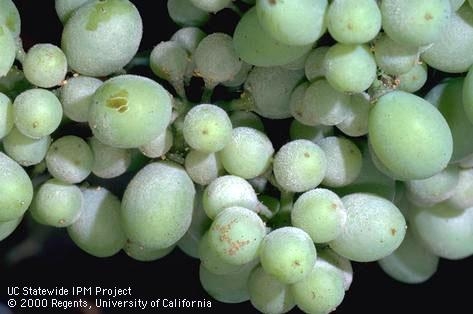Be Prepared for the 2010 Powdery Mildew Season
The 2009 grape growing season was marked by warm and cool spells that allowed for severe mildew outbreaks. The perfect environmental conditions produced large dense canopies in May with optimal conditions for powdery mildew growth in June. Our current mix of warm and cool weather in the San Joaquin Valley seems to be developing into another challenging season for powdery mildew management. Growers should consider an aggressive management program early on in order to reduce a repeat of the 2009 season. With the last few storms predicted to pass through the San Joaquin Valley in the next couple of weeks, warm weather will follow and powdery mildew will begin to grow at a rapid pace, requiring quick action to keep it in check.
Factors to consider for good powdery mildew management
As a result of last years high powdery mildew incidence seen in vineyards, growers and pesticide applicators should be proactive about their management programs during the 2010 season. There is a direct correlation between high populations experienced the previous year and the amount that will develop during the current season. This means that the most important fungicide applications this year will be the ones early in the season when shoots and canopies are small. Depending on the acreage that needs to be sprayed, growers should carefully select their application timing and product to be used based on past seasons mildew incidence and severity, cultivar susceptibility and the trellis system.
Grape cultivars have varying degrees of susceptibility to powdery mildew infection. Carignane is much more susceptible than Syrah and will need to be protected with a fungicide more frequently to avoid significant yield losses. With powdery mildews ability to grow exponentially under optimal conditions (spore to spore every 5 days), each vineyard should have a management plan that fits its characteristics to minimize damage. For example, vineyards planted to overhead trellises may need more fungicide applications than those planted to a single wire vertical trellis. However, at the end of the day, good coverage will dictate how well powdery mildew is managed and factors that improve coverage (i.e. nozzles, ground speed, etc.) should be identified and evaluated.
Using the PMI
Powdery mildew growth is temperature dependent and requires careful monitoring to optimize fungicide applications. The UC Davis powdery mildew index (PMI) is a tool that helps determine grapevine powdery mildew growth based on optimal canopy temperatures (70-85oF). With budbreak occurring in mid-March 2010 the PMI has been initiated with most sites meeting the 6 continuous hours between 70-85oF for three consecutive days. To follow the PMI growers can access the UC IPM website or follow us on Twitter (http://www.twitter.com/grapetweets) to receive weekly updates via the internet, your cell phone, or other mobile device.
The PMI is a tool that can be used to determine disease pressure and the frequency of fungicide applications.
Additional information:
For a more detailed discussion on grapevine powdery mildew and the use of the PMI go to:
http://ucipm.ucdavis.edu/PMG/r302100311.html
For PMI data in Fresno, Madera and San Joaquin Counties go to:
http://ucipm.ucdavis.edu/calludt.cgi/GRAPEPMVIEW1
For a cultivar susceptibility chart go to:
Attached Images:
